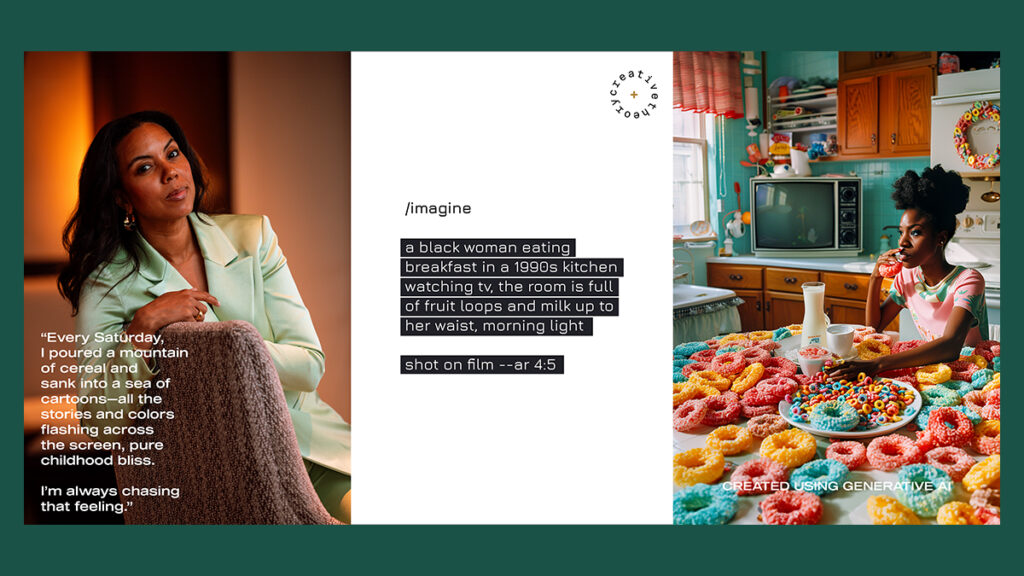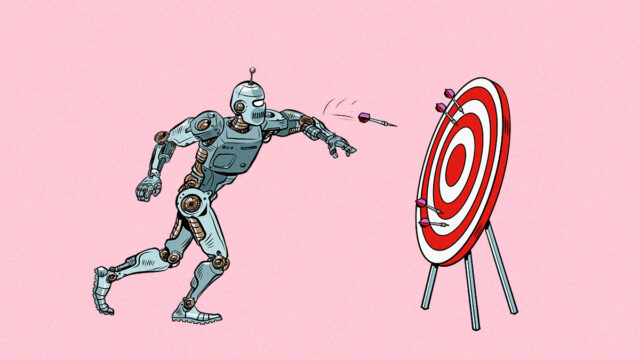Creative Agency Prompts AI to Make the Technology More Inclusive
Don’t miss ADWEEK House at Cannes, June 16-19. Join us as we celebrate our 45th anniversary and explore the industry’s now and next. RSVP.
Artificial intelligence is only as good as its prompts and its learning, which is why many creatives are wary of using it for campaigns. AI is also bad at representing inclusion and diversity in its images.
A new campaign from independent Black-owned Washington, D.C.-based agency Creative Theory Agency hopes to right those wrongs and get people more interested in involving AI to tell real stories of lived experiences.
“What Prompted You” is a campaign and call to action to showcase how first-person, organic human perspectives can enhance and uplevel creativity. By digging into lived experiences, each creative piece of the campaign conveys the unique elements of the subject’s experience, using sensory details where possible to enhance visualization prior to AI interpretation.
Tamon George, co-founder and CEO of Creative Theory Agency, said the agency, which works with tech giants like Google and Meta, was excited to use AI, but he didn’t see that same level of intentionality and thought that the agency brings to its work being brought to AI.
“As marketing advertisers, we quickly realized that if we were going to have a statement about this, and if we were going to share our voice in this particular moment, we needed to do it as advertisers in a way that resonated with the developers of some of these tools,” George told ADWEEK.
Going big with AI
The agency will put up large-scale out-of-home placements in Washington, D.C., showing real people telling their stories, with AI images setting a scene from their lives.
For instance, Dionna Dorsey, co-founder and CEO of Creative Ladder, a nonprofit connecting and elevating talent for a more inclusive industry, set a scene: “Every Saturday, I poured a mountain of cereal and sunk into a sea of cartoons—all the stories and colors flashing across the screen, pure childhood bliss. I’m always chasing that feeling.”
The resulting OOH placement shows a picture of Dorsey alongside her quote, with an AI image recreating her lived experience.

The agency was intentional about the talent it chose to highlight.
“We wanted them to be aligned with the (marketing and advertising) industry or aligned with access—are you providing access, and is access a part of your story?” Gary Williams, co-founder and chief creative officer at Creative Theory Agency, told ADWEEK.
Other featured talent includes chef Keem Hughley of Bronze restaurant, who has provided a platform for Black and Brown chefs to experiment and learn their craft, and Angel Gregorio, who created Black + Forth, a commercial space to amplify Black-owned businesses in her native Washington, D.C.
Prompting the right images
The mechanics of getting the right images took a lot of trial and error by the Creative Theory team. It took over 20 prompts through generative AI platform Midjourney to get the right nuanced image for each subject to tell the right story, and the technology doesn’t always cooperate.
“Sometimes you get hallucinations, where there’s six fingers, or there’s an eye missing, or there’s no arm. To get an image that we felt was aligned with their lived experience … you really kind of have to be specific in your prompts,” said Williams.
Each subject got to approve their images, giving the stories a human perspective.
“The point that we’re really trying to prove is that these images align with someone and their story. We needed to take (the AI image) out of isolation and place it literally next to somebody so that people can see it in its in its truest form,” added George.
The need for AI inclusivity
There is an inherent fear that AI will take jobs away from the creative field, and Creative Theory Agency is cognizant that there are things that AI will commoditize. What “What Prompted You” hopes to achieve is to start a conversation around the jobs the technology will create, like prompt engineer or AI developer. But all creators having access to the technology is key.
“If we don’t have access to these tools, to the systems, we are going to be left behind in acquiring some of those jobs. If we have more input, there will be less demystifying that needs to be done around the fear of AI and what it’s going to do to our industry,” said Williams.
If the campaign can start a conversation around getting people access to these tools—whether it’s the building, the testing or the using—then the industry can start another conversation around the jobs that are going to be created.
The large OOH placements will be in the Union Market area of Washington, D.C., and will drive traffic back to whatpromptedyou.com, which provides resources around ways to get involved and learn more about AI. The agency also hopes it has an impact on how big brands, including tech brands that are developing AI, look to the future with the technology so that it grows inclusively.
“We wanted to make sure that this was big enough in scale where some of our brand partners can see it—the people who are literally making massive investments in these tools for the next century,” said George.
Creative Theory Agency is hoping the campaign is a success so that it can do more placements in other cities, introducing more people’s stories.
“We don’t have a crystal ball to see what the future of these tools will be. But we know that we certainly need more people to be pushing for, and requiring, the type of nuance and thought and access to the development and deployment of the tools,” said George.
https://www.adweek.com/agencies/creative-agency-prompts-ai-to-make-the-technology-more-inclusive/
